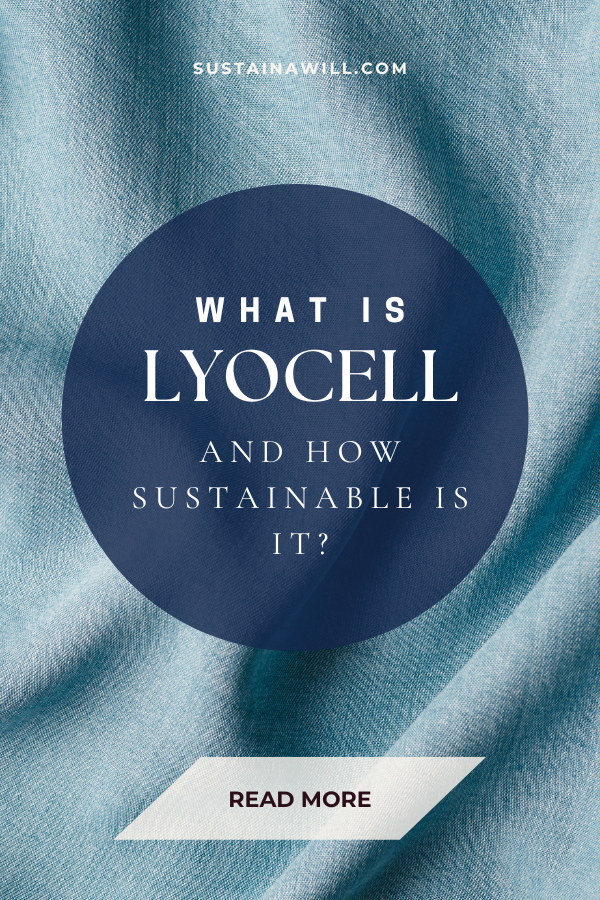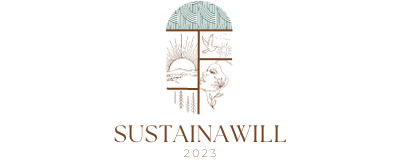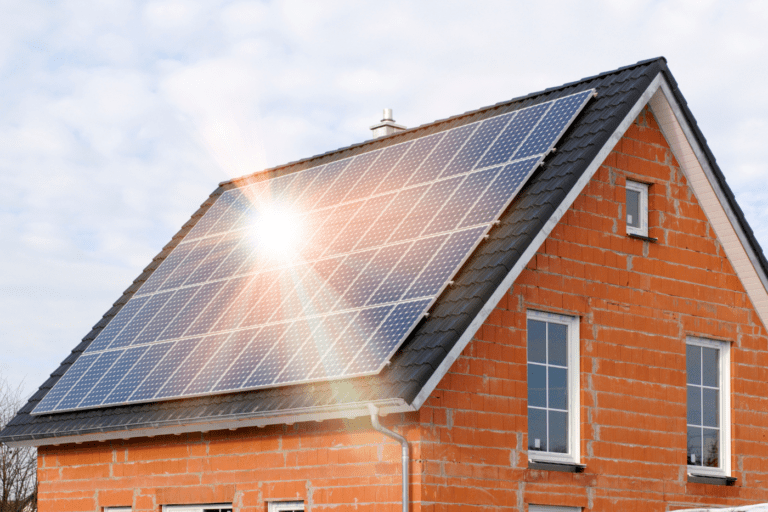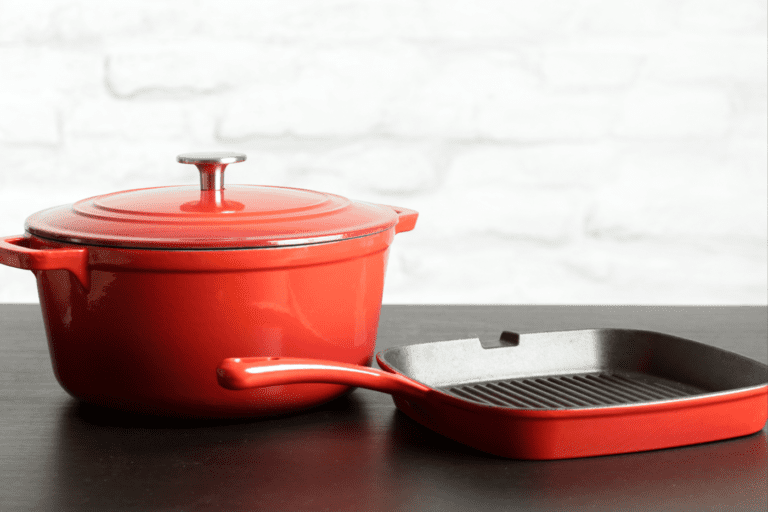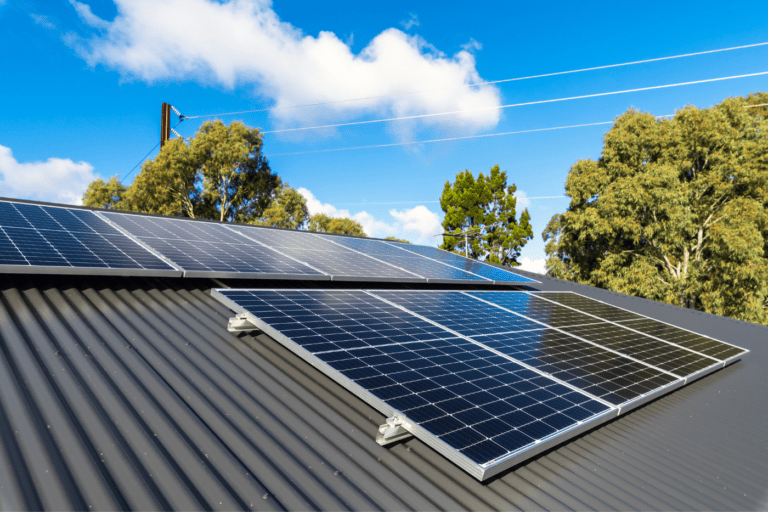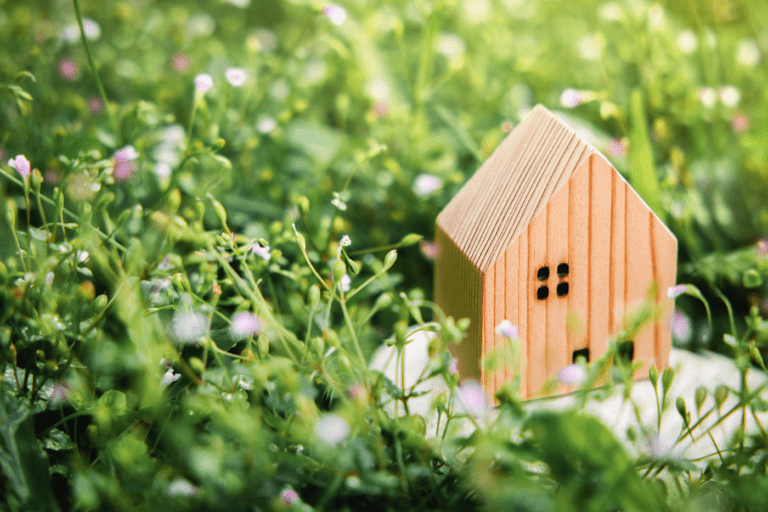Welcome to the world of Lyocell Fabric, often recognized by its popular brand name, Tencel.
If you’re curious about what makes this fabric unique and whether it aligns with sustainable practices, you’re in the right place.
By the end, you’ll gain insights into its sustainability, characteristics, and how choosing Lyocell can be a mindful and eco-conscious decision.
What is Lyocell Fabric (TENCEL) and how is it made?
Lyocell, commonly known by the brand name TENCEL, is a type of rayon derived from wood pulp, typically sourced from eucalyptus trees.
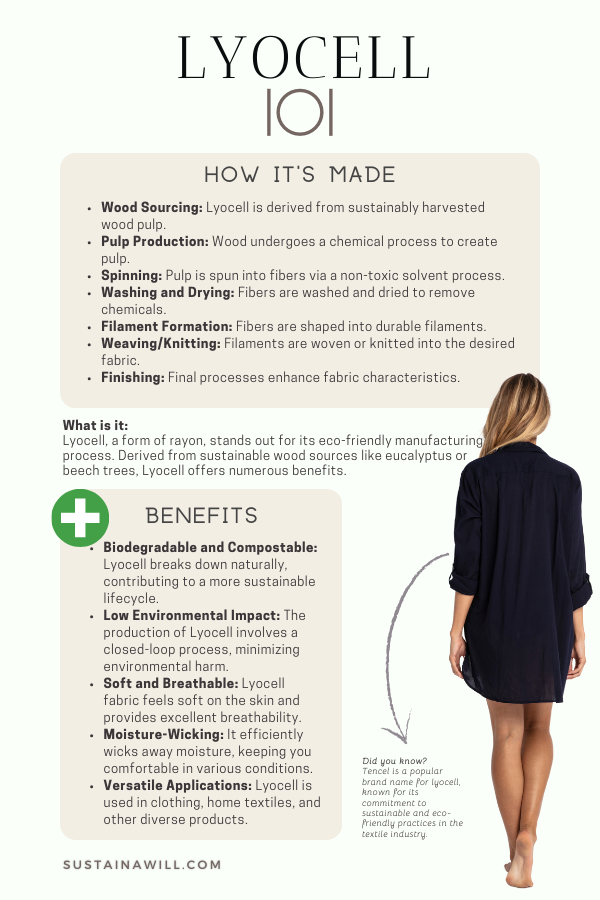
The process of making Lyocell involves the following steps:
- Harvesting and Pulping: The wood pulp is obtained from sustainably managed eucalyptus forests. The trees are harvested, and the pulp is extracted.
- Solvent Spinning: The wood pulp is dissolved in a non-toxic solvent, creating a solution. This solution is then extruded through fine holes to form filaments.
- Washing and Recovery: The filaments are washed to remove impurities and solvents. The solvent is collected and reused in a closed-loop process, minimizing environmental impact.
- Drying: The washed filaments are dried to produce lyocell fibers.
The production of Lyocell using the closed-loop process is considered environmentally friendly and sustainable. It requires less water and energy compared to traditional rayon production methods.
For an in-depth look at the Tencel production process by its inventors, check out this video from Lenzing AG: Watch here.
Are Tencel and Lyocell the same?
Tencel is a brand name for a type of lyocell fabric. Lyocell is the generic name for the material, while Tencel is a specific brand of lyocell known for its high-quality production and sustainability practices.
Who invented Tencel?
Tencel was developed by the Austrian company Lenzing AG. They introduced Tencel as a brand name for their lyocell fiber in the 1990s.
What is Lyocell (TENCEL) used for?
Lyocell, including the Tencel brand, is a versatile fabric used for various applications, including:
- clothing
- home textiles
- and non-woven products
Its softness, breathability, and sustainable production make it popular for apparel like:
- shirts
- dresses
- and activewear
Additionally, it is used in:
- bedding
- towels
- and other home goods
due to its comfort and eco-friendly properties.
Is Lyocell (TENCEL) eco-friendly and sustainable?
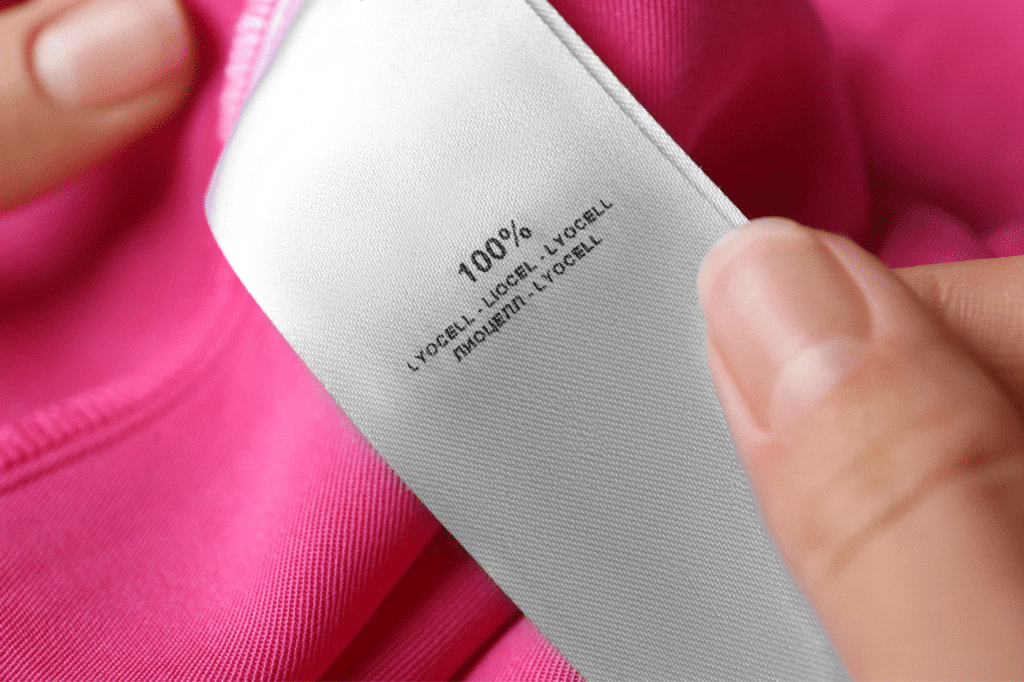
Lyocell, particularly under the Tencel brand, is considered highly eco-friendly and sustainable. It is produced from sustainably sourced wood pulp, often from eucalyptus trees, using a closed-loop process that minimizes environmental impact.
The closed-loop process recycles and reuses solvents, making it more resource-efficient.
Summary
- Sustainably Sourced: Lyocell is derived from sustainably sourced wood pulp, reducing the environmental impact.
- Closed-Loop Process: The closed-loop production process minimizes waste and efficiently reuses solvents.
- Renewable Resource: Eucalyptus trees, a common source for Lyocell, are renewable and grow quickly.
How long does Lyocell (TENCEL) take to biodegrade?
Lyocell is biodegradable and typically decomposes relatively quickly compared to synthetic materials. Under good composting conditions, it can break down within a few weeks to a few months, contributing to a more sustainable end-of-life cycle.
However, specific biodegradation times can depend on environmental conditions and disposal methods.
Summary
- Rapid Biodegradation: Lyocell biodegrades more quickly than many synthetic materials.
- Compostable: It can be composted, returning nutrients to the soil.
- Environmentally Friendly End-of-Life: Contributes to a more sustainable disposal cycle.
What are the advantages and disadvantages of Lyocell (TENCEL)?
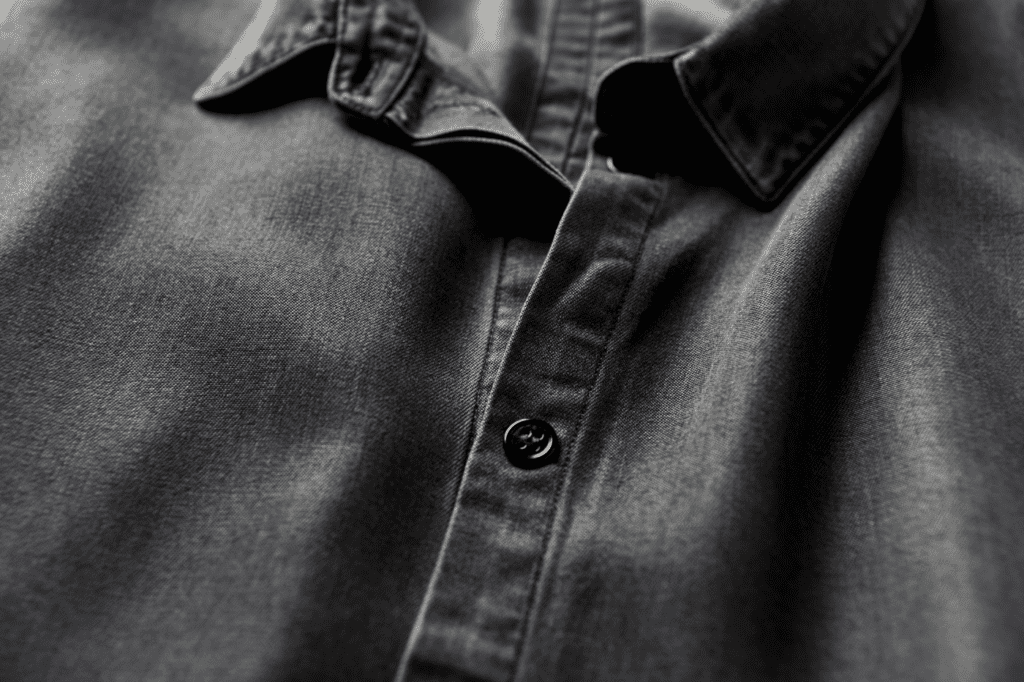
Advantages of Lyocell (TENCEL)
- Eco-Friendly Production: The closed-loop process used to manufacture Tencel is environmentally friendly, with minimal impact on ecosystems.
- Sustainable Raw Materials: Tencel is often derived from sustainably sourced wood pulp, such as eucalyptus, contributing to forest conservation.
- Biodegradable: Tencel is biodegradable, breaking down naturally over time and reducing environmental impact.
- Soft and Breathable: Tencel fabric is known for its softness, breathability, and comfort, making it a popular choice for clothing.
- Moisture-Wicking: The fabric has excellent moisture-wicking properties, keeping the skin dry.
Disadvantages of Lyocell (TENCEL)
- Cost: Tencel products can be more expensive compared to conventional fabrics due to the production process and sourcing of sustainable materials.
- Chemical Processing: While the closed-loop process minimizes environmental impact, chemicals are still involved in the production of Tencel.
- Limited Color Range: Tencel fabrics may have limitations in terms of available colors compared to synthetic alternatives.
- Durability: While generally durable, Tencel fabrics may not be as resistant to abrasion as some synthetic fabrics.
It’s important to note that the advantages often align with sustainability and comfort, but cost considerations and specific use cases may influence individual preferences.
Lyocell (TENCEL) Vs Other Fabrics
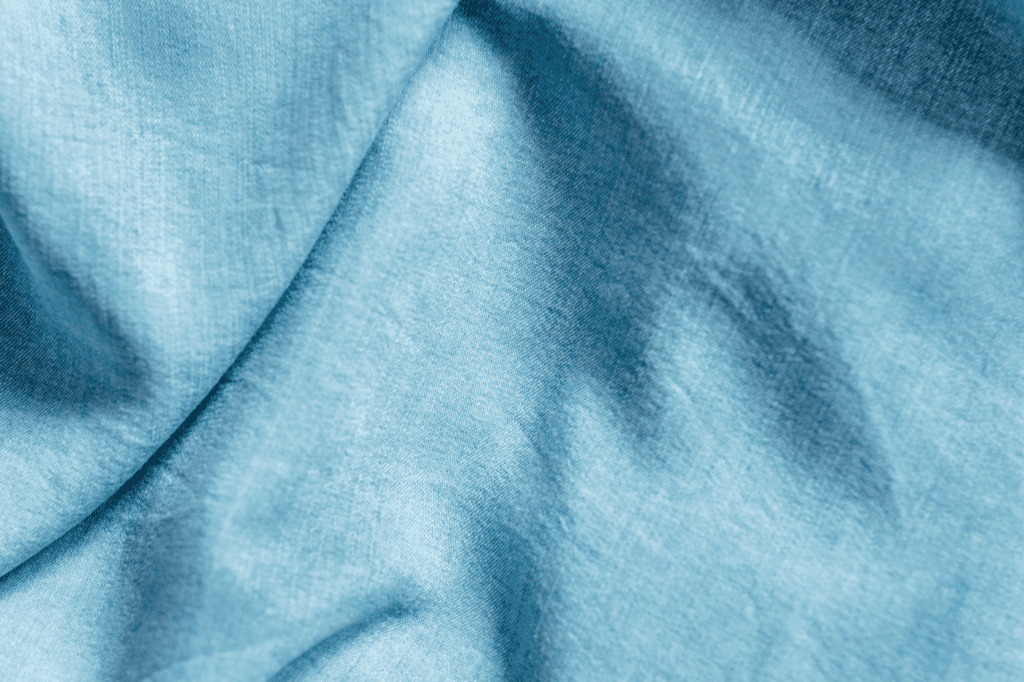
Is Lyocell (TENCEL) more eco-friendly than cotton?
Yes, Lyocell (TENCEL) is considered more eco-friendly than conventional cotton.
The closed-loop production process of Tencel, which uses less water and chemicals, contributes to its environmental sustainability compared to traditional cotton farming.
Is Lyocell more sustainable than viscose?
Yes, Lyocell (TENCEL) is considered more sustainable than conventional viscose.
The closed-loop manufacturing process used in Tencel production reduces environmental impact and resource use compared to certain methods of viscose production.
Is Silk or Tencel better?
For us the winner is Tencel.
Choosing between silk and Tencel depends on specific preferences and priorities.
Tencel is more eco-friendly, produced in a closed-loop process, and derived from sustainably sourced wood pulp.
Silk, while natural, involves the harvesting of silkworms, raising ethical considerations.
FAQs about TENCEL

Does Tencel create microplastics?
No, Tencel is a cellulosic fiber derived from wood pulp using a closed-loop process, and it does not shed microplastics during washing.
Is Tencel a luxury fabric?
Yes, Tencel is often considered a luxurious fabric due to its smooth texture, softness, and sustainable production methods.
Why is Lyocell expensive?
The cost of Lyocell (Tencel) can be higher due to its eco-friendly production process, which involves sustainable sourcing, closed-loop manufacturing, and advanced technology.
Why is Tencel so popular?
Tencel has gained popularity due to its sustainable and eco-friendly attributes, including a closed-loop production process, soft feel, and versatility in various applications.
Is Tencel good to wear in summer?
Yes, Tencel is a breathable fabric that wicks away moisture, making it suitable for summer wear. It provides comfort by regulating body temperature.
Is Tencel pure cotton?
No, Tencel is not pure cotton. It is a distinct fiber made from wood pulp, whereas cotton comes from the fibers of the cotton plant.
Which countries produce Tencel?
Tencel is produced globally, with major manufacturing countries including Austria, the United States, the United Kingdom, and China.
Is Tencel plant-based?
Yes, Tencel is plant-based as it is derived from wood pulp, usually sourced from sustainably managed eucalyptus trees.
Is Tencel a microfiber?
No, Tencel is not considered a microfiber. Microfibers are typically synthetic, while Tencel is a natural, cellulosic fiber.
Is Tencel hot to sleep on?
No, Tencel is known for its temperature-regulating properties, making it suitable for various climates. It can keep you cool in warmer temperatures and provide warmth in cooler conditions.
Conclusion
As we conclude our exploration into the world of Lyocell (Tencel), you’ve unlocked the secrets of a fabric that seamlessly combines sustainability with comfort and versatility.
Armed with this knowledge, you possess the power to make informed and eco-conscious choices. The call to action is simple: the next time you shop for clothing or consider home textiles, look for the gentle embrace of Lyocell.
Your choices matter, and together, we can weave a fabric of change for a better world. Happy and mindful shopping!
